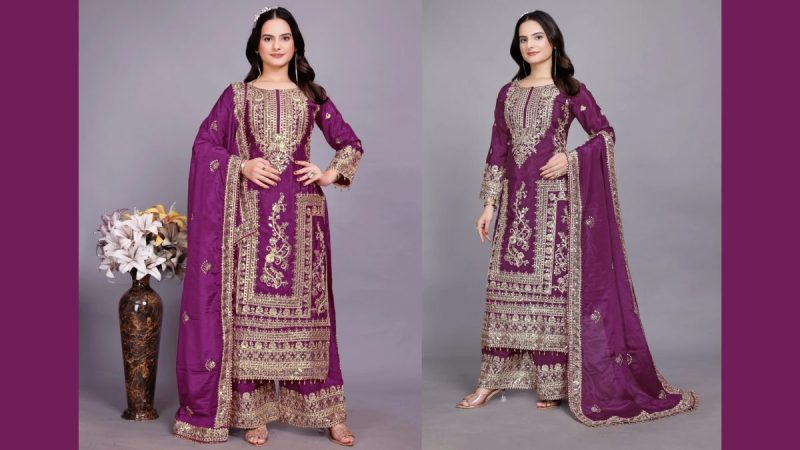Pakistani Suits vs Indian Suits: Key Differences in Style, Fabric, and Embroidery
Ethnic wear is more than just clothing in South Asia—it is a reflection of culture, tradition, and timeless beauty. Among the most iconic outfits, Pakistani suits for women and Indian suits for women remain the most loved choices. While they may appear similar to someone unfamiliar with South Asian fashion, they carry unique features that make them distinct. From the cut of the kameez to the choice of fabrics and embroidery styles, both Pakistani and Indian suits tell their own cultural story.
In this article, we’ll explore the key differences between Pakistani suits and Indian suits, covering their style, fabrics, embroidery, regional influences, and modern trends.

A Quick Cultural Background: Pakistani Suits & Indian Suits
Before diving into fashion details, it’s worth understanding the cultural roots.
- Pakistani Suits:
These outfits evolved from traditional shalwar kameez, which is Pakistan’s national dress. Over the years, Suits have incorporated elegant modifications like long kameez with straight trousers, palazzos, or churidars, making them versatile for both everyday and festive wear. - Indian Suits:
In India, the suit evolved from Mughal-era attire and gradually merged with regional fashion. From Patiala suits in Punjab to silk Anarkalis in South India, the diversity is immense. Indian suits are known for their boldness, color variety, and regional richness.
Style and Silhouette
- Pakistani Suits:
Suits usually have longer and flowy kameez paired with slim trousers or churidars. The fit is often modest yet elegant, perfect for women who prefer graceful ethnic wear with comfort. Modern designers are also introducing Pakistani lawn suits for summer and Pakistani chiffon suits for weddings, giving women both casual and formal options. - Indian Suits:
Indian suits are more experimental in style. From short kurtis with Patiala salwars to heavily flared Anarkalis, Indian suits offer a wide variety. Many women choose designer Indian suits for weddings as they provide a bold, festive, and glamorous look.
Fabrics and Textures
- Pakistani Suits:
Pakistan’s climate has a huge influence on fabric choices. Light materials like lawn cotton, chiffon, georgette, and silk blends dominate. Pakistani lawn suits online shopping is especially popular during summer because of their breathability. - Indian Suits:
Indian suits showcase more fabric diversity. From banarasi silk suits in Uttar Pradesh to cotton salwar suits in Punjab and velvet suits in Kashmir, each region has its specialty. For special occasions, Indian silk suits for weddings are the top pick.
Embroidery and Embellishments
- Pakistani Suits:
Pakistani embroidery is usually elegant and understated. Popular techniques include zari, dabka, tilla, resham, and threadwork. Women prefer Pakistani suits with light embroidery for parties and office wear because they strike a balance between beauty and comfort. - Indian Suits:
Indian embroidery is often heavier and more vibrant. Techniques like zardozi, gota patti, mirror work, and kundan embroidery are common. For bridal outfits, bridal Indian suits with heavy embroidery are highly sought after.
Color Palette
- Pakistani Suits:
Pakistani designers love soft and pastel colors—mint green, beige, baby pink, and powder blue dominate casual collections. However, for weddings, Pakistani suits in maroon, emerald, and navy blue remain popular. - Indian Suits:
Indian suits embrace a bright and bold palette. From red Indian suits for weddings to vibrant yellow and orange for festivals, colors play a major role in Indian fashion. Recently, pastels have also entered the wedding scene for day events.
Dupatta Styles
- Pakistani Suits:
Dupattas are long, flowy, and usually lightweight. Pakistani suits with chiffon dupattas are very popular as they add elegance without being too heavy. - Indian Suits:
Dupattas in Indian suits are often heavily embroidered with zari or sequins. Brides frequently choose the double dupatta Indian suit style for weddings to add grandeur.
Regional Influences
- Pakistan:
- Karachi & Lahore: Known for trendy Pakistani designer suits online featuring chiffon and silk.
- Punjab (Pakistan): Famous for embroidered lawn suits that are simple yet elegant.
- India:
- Punjab (India): Patiala salwar suits with vibrant colors and phulkari embroidery.
- Uttar Pradesh: Banarasi silk suits with gold zari work.
- Rajasthan & Gujarat: Mirror work and bandhani designs in salwar suits.
- South India: Elegant silk Anarkali suits for weddings and festivals.
Modern Styling Tips for Pakistani Suits
- Pair Pakistani suits with cigarette pants for a chic, modern look.
- Add statement jewelry like jhumkas and bangles with Indian Anarkali suits for weddings.
- For workwear, choose Pakistani cotton lawn suits with light embroidery for comfort.
- Brides can experiment with the double dupatta drape in Indian suits for a royal feel.
Conclusion
Both Pakistani suits and Indian suits are beautiful representations of South Asian heritage. Suits are renowned for their elegance, modest silhouettes, and breathable fabrics, while Indian suits are celebrated for their vibrant colors, bold embroidery, and rich regional diversity. Whether you choose suits for daily wear or Indian suits for weddings, both outfits allow women to showcase tradition with style.
Still confused between Pakistani and Indian suits? Whether you want something elegant for daily wear or a heavily embroidered outfit for weddings, the right choice is just a click away. Explore stunning collections of Pakistani and Indian suits online and upgrade your ethnic wardrobe today!






